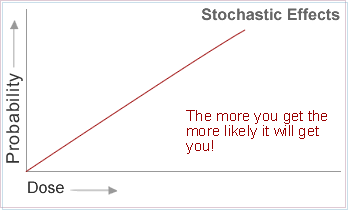Radiobiology and the Classification of Biological Effects
Stochastic Effects
- Stochastic Effects 1
- Stochastic Effects 2
- Stochastic Effects 3
- Stochastic Effects 4
- Stochastic Effects 5
In the human body many millions of ion pairs (electrically charged particles originating from the breaking-up of molecules) are created in the DNA each year from exposure to natural background radiation.
However, very few cancer deaths are attributable to this exposure. Therefore the electro-chemical, chemical, and biological processes resulting from the creation of an ion pair to a modified cell must very rarely be completed. A group of cells which are damaged or modified, for whatever reason, may in most cases be isolated and destroyed by the body's defence mechanisms.
However, if the group is allowed to develop, a malignant condition may be reached in which the production of modified cells is uncontrolled. This occurs after a delay of variable length called the latency period.
Malignancies induced as a result of radiation damage are not distinguishable from those induced by other causes. Because the body's defences are not completely effective, the smallest number of modified cells may develop into a cancer and there is assumed to be no threshold above which effects occur.
Because the probability of a cancer developing is partly dependent on the initial number of modified cells, these so-called stochastic effects occur with a probability rather than severity of effect being a function of radiation dose. Stochastic somatic effects are restricted to cancers only and are normally expressed as a risk of the effect occurring per unit dose.
The extrapolation of data from epidemiological studies has led the ICRP through a series of risk projection models to estimate the probability of occurrence of fatal and non-fatal cancers, as well as hereditary effects for a given annual dose received each year for a working lifetime.
In diagnostic radiology and nuclear medicine, with the exception of I-131 therapies, exposure levels are expected to be such that any biological effects to both patient and staff are stochastic in nature.
For Stochastic Effects we witness a Probabilistic behaviour, we have to assume effects possible even at lowest dose levels, some delay likely before effect is seen.
Acute Radiation syndromes – high level dose deterministic effects
Acute radiation syndromes are described below. These occur after large radiation dose over short period of time. In order of sensitivity:
- Skin (erythemia),
- GI Tract (GI syndrome),
- Bone Marrow (Haematopoietic syndrome),
- Central Nervous System (CNS syndrome)
Also chronic radiation exposure occurs after repeated exposure to large or moderate doses. Sensitive organs:
- Lens of Eye (Cataracts) threshold of ~6000mSv,
- Skin (Radiation Dermatitis ~ 6000mSv),
- Gonads (Permanent Sterility) ~3000mSv.

Stochastic effects
There is a latency period from radiation exposure to effect being apparent – for stochastic effects such as cancer this can be tens of years.
A linear dose / risk model is used which is assumed to pass through the origin.
The latency periods can be 5-10 years for leukaemia and 20 – 30 years for solid cancers. Also effects can be expressed in future generations (not just the next generation).